1. The resultant force acting on a particle executing simple harmonic motion is 4 N when it is 5 cm away from the centre of oscillation. Find the spring constant.
Sol. The simple harmonic motion is defined as
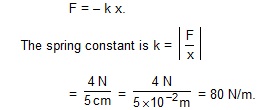
2. A particle of mass 0.50 kg executes a simple harmonic motion under a force F = – (50 N/m)x. If it crosses the centre of oscillation with a speed of 10 m/s, find the amplitude of the motion.
Sol. The kinetic energy of the particle when it is at the centre of oscillation is
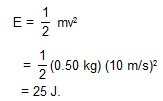
The potential energy is zero here. At the maximum displacement x = A, the speed is zero and hence the kinetic energy is zero. The potential energy here is kA2. As there is no loss of energy,
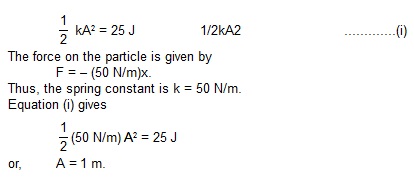
3. A particle of mass 200 g executes a simple harmonic motion. The restoring force is provided by a spring of spring cosntant 80 N/m. Find the time period.
Sol. The time period is
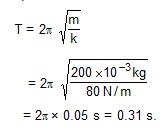
4. A particle executes simple harmonic motion of amplitude A along the X-axis. At t = 0, the position of the particle is x = A/2 and it moves along the positive x - direction. Find the phase constant d if the equation is written as x = A sin (wt + d).
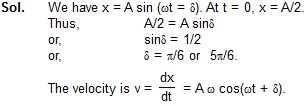

5. A particle of mass 40 g execute a simple harmonic motion of amplitude 2.0 m. If the time period is 0.20 s, find the total mechanical energy of the system.
Sol. The total mechanical energy of the system is

6. A body makes angular simple harmonic motion of amplitude p/10 rad and time period0.05 s. If the body is at a displacement p/10 rad at t = 0, write the equation giving the angular displacement as a function of time.
Sol. Let the required equation be
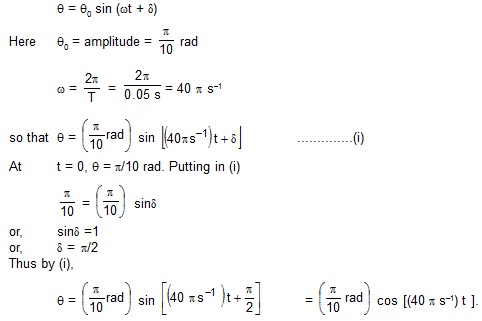
7. Calculate the time period of a simple pendulum of length one meter. The acceleration due to gravity at the place is

8. In a laboratory experiment with simple pendulum it was found that it took 36 s to complete 20 oscillations when the effective length was kept at 80 cm. Calculate the acceleration due to gravity from these data.
Sol. The time period of a simple pendulum is given by
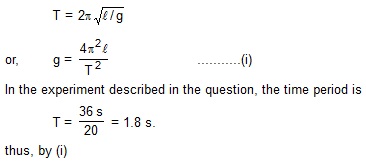
![]()
9. A uniform rod of length 1.00 m is suspended through an end and is set into oscillation with small amplitude under gravity. Find the time period of oscillation.
Sol. For small amplitude the angular motion is nearly simple harmonic and the time period is given by
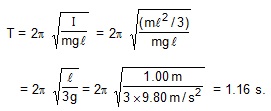
10. A uniform disc of radius 5.0 cm and mass 200 g is fixed at its centre to a metal wire, the other end of which is fixed with a clamp. The hanging disc is rotated about the wire through an angle and is released. If the disc makes torsional oscillations with time period 0.20 s, find the torsional constant of the wire.
Sol. The situation is shown in figure. The moment of inertia of the disc about the wire is

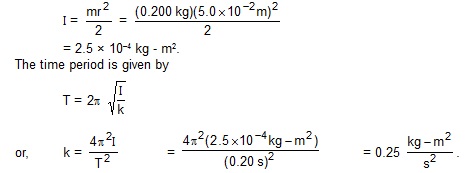
11. Find the amplitude of the simple harmonic motion obtained by combining the motions
![]()
Sol. The two equations given represent simple harmonic motions along X-axis with amplitudes A1 = 2.0 cm and A2 = 2.0 cm. The phase differnce between the two simple harmonic motions is p/3. The resultant simple harmonic motion will have an amplitude A given by

Questions for Short answer
1. A person goes to bed at sharp 10.00 pm every day. It is an example of periodic motion? If yes, what is the time period ? If no, why ?
2. A particle executing simple harmonic motion comes to rest at the extreme positions. Is the resultant force on the particle zero at these positions according to Newton’s first law?
3. Can simple harmonic motion take place in a noninertial frame? If yes, should the ratio of the force applied with the displacement be constant ?
4. A particle executes simple harmonic motion. If you are told that its velocity at this instant is zero, can you say what is its displacement ? If you are told that its velocity at this instant is maximum, can you say what is its displacement ?
5. A small creature moves with constant speed in a vertical circle on a bright day. Does its shadow formed by the sun on a horizontal plane move in a simple harmonic motion ?
6. A particle executes simple harmonic motion. Let P be a point near the mean position and Q be a point near an extreme. The speed of the particle at P is larger then the speed at Q. Still the particle crosses P and Q equal number of times in a given time interval. Does it make you unhappy ?
7. In measuring time period of a pendulum, it is advised to measure the time between consecutive passage through the mean position in the same direction. This is said to result in better accuracy than measuring time between consecutive passage through an extreme position. Explain.
8. It is proposed to move a particle in simple harmonic motion on a rough horiozntal surface by applying an external force along the line of motion. Sketch the graph of the applied forceagainst the position of the particle. Note that the applied force has two values for a given position depending on whether the particle is moving in positive or negative direction.
9. Can the potential energy in a simple harmonic motion be negative? Will it be so if we choose zero potential energy at some point other than the mean position ?
10. The energy of a system in simple harmonic motion is given by E = mw2A2. Which of the following two statements is more appropriate ?
(A) The energy is increased because the amplitude is increased.
(B) The amplitude is increased because the energy is increased.
11. A pendulum clock gives correct time at the equator. Will it gain time or loose time as it is taken to the poles ?
12. Can a pendulum clock be used in an earth satellite ?
13. A hollow sphere filled with water is used as the bob of a pendulum. Assume that the equation for simple pendulum is valid with the distance between the point of suspension and centre of mass of the bob acting as the effective length of the pendulum. If water slowly leaks out of the bob, how will the time period vary ?
14. A block of known mass is suspended from a fixed support through a light spring. Can you find the time period of vertial oscillation only by measuring the extension of the spring when the block is in equilibrium.
15. A platoon of soldiers marches on a road in steps according to the sound of a marching band. The band is stopped and the soldiers are ordered to break the steps while crossing a bridge. Why ?
16. The force acting on a particle moving along X-axis is F = – k(x – v0t) where k is a positive cosntant. An observer moving at a constant velocity v0 along the X-axis looks at the particle. What kind of motion does he find for the particle?
Objective - I
1. A student says that he had applied a force F – k/x on a particle and the particle moved in simple harmonic motion. He refuses to tell whether k is a constant or not. Assume that he has worked only with positive x and no other force acted on the particle.
(A*) As x increases k increases
(B) As x increases k decreases
(C) As x increases k remains constant.
(D) The motion cannot be simple harmonic.
2. The time period of a particle in simple harmonic motion is equal to the time between consecutive appearance of the particle at a particular point in its motion. This point is
(A) the mean position
(B*) an extreme position
(C) between the mean position and the positive extreme
(D) between the mean position and the negative extreme.
3. The time period of a particle in simple harmonic motion is equal to the smallest time between the particle acquiring a particular velocity . The value of v is
(A*) vmax (B) 0
(C) between 0 and vmax (D) between 0 and –vmax
4. The displacement of a particle in simple harmonic motion in one time period is
(A) A (B) 2A (C) 4A (D*) zero
5. The distance moved by a particle in simple harmonic motion in one time period is
(A) A (B) 2A (C*) 4A (D) zero
6. The average acceleration in one time period in a simple harmonic motion is
![]()


9. A particle moves on the X-axis according to the equation x = A + B sin wt. The motion is simple harmonic with amplitude
![]()
10. Figure represents two simple harmonic motions. The parameter which has different values in the two motions is

(A) amplitude (B) frequency (C*) phase (D) maximum velocity

![]()
12. The average energy in one time period in simple harmonic motion is

13. A particle executes simple harmonic motion with a frequency v. The frequency with which the kinetic energy oscillates is
(A) v/2 (B) v (C*) 2v (D) zero
14. A particle executes simple harmonic motion under the restoring force provided by a spring. The time period is T. If the spring is divided in two equal parts and one part is used to continue the simple harmonic motion, the time period will
![]()
15. Two bodies A and B of equal mass are suspended from two separate massless springs of spring cosntant k1 and k2 respectively. If the bodies socillate vertically such that their maximum velocities are equal, the ratio of the amplitude of A to that of B is
![]()
16. A spring mass system oscillates with a frequency v. If it is taken in an elevator slowly accelerating upward, the frequency will
(A) increase (B) decrease (C*) remain same (D) become zero
17. A spring-mass system oscillates in a car. If the car accelerates on a horizontal road, the frequency of oscillation will
(A) increase (B) decrease (C*) remain same (D) become zero.
18. A pendulum clock that keeps correct time on the earth is taken to the moon. It will run
![]()
19. A wall clock uses a vertical spring-mass system to measure the time. Each time the mass reaches an extreme position, the clock advances by a second. The clock gives correct time at the equator. If the clock is taken to the poles it will
(A) run slow (B) run fast (C) stop working (D*) give correct time.
20. A pendulum clock keeping correct time is taken to high altitudes,
(A) it will keep correct time
(B) its length should be increased to keep correct time
(C*) its length should be decreased to keep correct time
(D) it cannot keep correct time even if the length is changed.
21. The free end of a simple pendulum is attached to the ceiling of a box. The box is taken to a height and the pendulum is oscillated. When the bob is at its lowest point, the box is released to fall freely. As seen from the box during this period, the bob will
(A) continue its oscillation as before (B) stop
(C*) go in a circular path (D) move on a straight line.
Objective - II
1. Select the correct statements.
(A*) a simple harmonic motion is necessarily periodic (B*) a simple harmonic motion is necessarily oscillatory
(C) an oscillatory motion is necessarily periodic (D) a periodic motion is necessarily oscillatory
2. A particle moves in a circular path with a uniform speed. Its motion is
(A*) periodic (B) oscillatory
(C) simple harmonic (D) angular simple harmonic
3. A particle is fastened at the end of a string and is whirled in a vertical circle with the other end of the string being fixed. The motion of the particle is
(A*) periodic (B) oscillatory
(C) simple harmonic (D) angular simple harmonic
4. A particle moves in a circular path with a continuously increasing speed. Its motion is
(A) periodic (B) oscillatory (C) simple harmonic (D*) none of them
5. The motion of a torsional pendulum is
(A*) periodic (B*) oscillatory
(C) simple harmonic (D*) angular simple harmonic
6. Which of the following quantities are always negative in a simple harmonic motion ?
![]()
7. Which of the following quantities are always positive in a simple harmonic motion ?
![]()
8. Which of the following quantities are always zero in a simple harmonic motion ?
![]()
9. Suppose a tunnel is dug along a diameter of the earth. A particle is dropped from a point, a distance h directly above the tunnel. The motion of the particle as seen from the earth is
(A) simple harmonic (B) parabolic (C*) on a straight line (D*) periodic
10. For a particle executing simple harmonic motion, the acceleration is proportional to
(A*) displacement from the mean position
(B) distance from the mean position
(C) distance travelled since t = 0
(D) speed
11. A particle moves in the X-Y plane according to the equation
![]()
The motion of the particle is
(A*) on a straight line (B) on an ellipse (C*) periodic (D*) simple harmonic


13. In a simple harmonic motion
(A) the potential energy is always equal to the kinetic energy
(B) the potential energy is never equal to the kinetic energy
(C) the average potential energy in any time interval is equal to the average kinetic energy in that time interval
(D*) the average potential energy in one time period is equal to the average kinetic energy in this period.
14. In a simple harmonic motion
(A*) the maximum potential energy equals the maximum kinetic energy
(B*) the minimum potential energy equals the minimum kinetic energy
(C) the minimum potential energy equals the maximum kinetic energy
(D) the maximum potential energy equals the minimum kinetic energy
15. An object is released from rest. The time is takes to fall through a distance h and the speed of the object as it falls through this distance are measured with a pendulum clock. The entire apparatus is taken on the moon and the experiment is repeated
(A*) the measured times are same (B*) the measured speeds are same
(C) the actual times in the fall are equal (D) the actual speeds are equal
16. Which of the following will change the time period as they are taken to moon ?
(A*) A simple pendulum (B*) A physical pendulum
(C) a torsional pendulum (D) a spring mass system